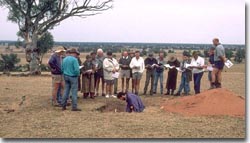Landholder Groups
The North East Landcare website (external link) provides information on Landcare Networks and Landcare Groups in the North East region.
The North East Regional Landcare Plan was developed in 1993. It's primary purpose was to provide:
- An overview of natural resource problems and solutions based on current information.
- A framework for coordinated action to address priority Landcare issues.
- A rational basis for assessing Landcare programs and recommending appropriate distribution of resources within the North East.
- A basis for agreements with the Commonwealth for allocation of Federal funds.
Further information can be found on the Landcare Australia website (external link).
There were 48 Landcare or related community groups operating in the North East region during the 1998/99 year. Of these, about 42 were involved in projects which gained funding for a range of works through Natural Heritage Trust (external link) or Victorian community grants. Many groups were involved in multiple projects. |  Soil Pit Field Day held for the Springurst-Byawatha Hills Landcare Group. |
Group projects undertake a wide range of activities including major rabbit harbour destruction, weed infestation reduction, salinity prevention, gully and streambank erosion prevention, fencing and revegetation, remnant vegetation protection, education and planning. Results obtained so far include about 38 500 hectares of private land with an average of 35% of total area treated to provide long-term rabbit control under the ‘Rabbit Buster’ program. Another achievement is that approximately 80 hectares of perennial pastures have been established for salinity prevention.
(NECMA, 1999)
Landcare Groups in the North East were among the first in the state to be established and continue to be amongst the most active. The achievements of Landcare in the region have been extensively surveyed by Curtis (1995). However, it was also found that ‘at the current levels of adoption of best management practices, Landcare Group activity is unlikely to have a significant impact on the management of land degradation at the catchment level’.
(NECALPB, 1997).
A recent study of Landcare throughout the North East region assessed the membership of Landcare groups, why they formed, individuals’ perceptions and what has worked for the groups. It also discusses commonly raised issues for Landcare members in the North East (such as the implications of volunteer work, paperwork/administration and their relationship to government). It draws conclusions regarding the technical, monetary, time and other assistance required by Landcare groups in the North East. A balance between the needs of organisations to provide efficient support, and the needs of groups to maintain their individuality, is vital if Landcare is to continue to be a useful force in natural resource management (Allan, 1999).
For up to date information about Landcare Groups and locations within the North East region, contact:
Tom Croft
Regional Landcare Coordinator
North East Catchment Management Authority (external link).
1B Footmark Court
Wodonga
Victoria
3689
Phone: (02) 6043 7600
Email: Tom.Croft@necma.vic.gov.au
References
Allan, C. (1999). Conversing with the carers: a snapshot of Landcare in north east Victoria, NRE, Wodonga.
Curtis, A. (1995). Landcare in Victoria: the state of play. Charles Sturt University, Johnstone Centre of Parks, Recreation and Heritage. Report no. 24.
North East Catchment and Land Protection Board (NECALPB) (1997). Regional Catchment Strategy, Victoria.
North East Catchment Management Authority (1999). Annual Report 1998-99. Wodonga.


